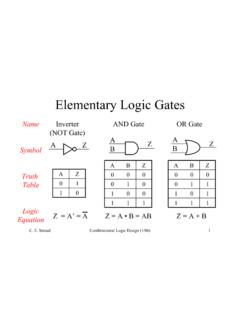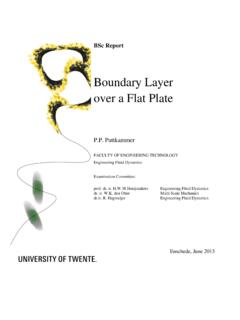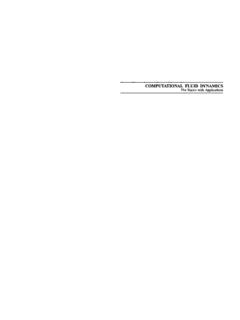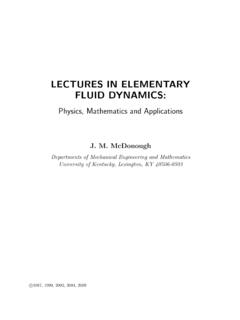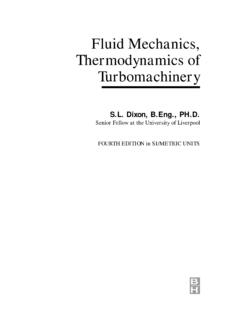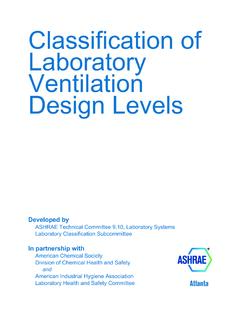Transcription of Chapter 2 Governing Equations of Fluid Dynamics
1 Chapter 2 Governing Equations of Fluid Anderson, IntroductionThe cornerstone of computational Fluid Dynamics is the fundamental governingequations of Fluid Dynamics the continuity, momentum and energy Equations speak physics. They are the mathematical statements of three fun-damental physical principles upon which all of Fluid Dynamics is based:(1) mass is conserved;(2)F=ma (Newton s second law);(3) energy is purpose of this Chapter is to derive and discuss these purpose of taking the time and space to derive the Governing Equations offluid Dynamics in this course are three-fold:(1) Because all of CFD is based on these Equations , it is important for each studentto feel very comfortable with these Equations before continuing further with hisor her studies, and certainly before embarking on any application of CFD to aparticular problem.
2 (2) This author assumes that the attendees of the present VKI short course comefrom varied background and experience. Some of you may not be totally fa-miliar with these Equations , whereas others may use them every day. For theformer, this Chapter will hopefully be some enlightenment; for the latter, hope-fully this Chapter will be an interesting review.(3) The Governing Equations can be obtained in various different forms. For mostaerodynamic theory, the particular form of the Equations makes little , for CFD, the use of the Equations in one form may lead to success,whereas the use of an alternate form may result in oscillations (wiggles) inthe numerical results, or even instability. Therefore, in the world of CFD, thevarious forms of the Equations are of vital interest.
3 In turn, it is important toderivethese Equations in order to point out their differences and similarities,and to reflect on possible implications in their application to Anderson, Air and Space Museum, Smithsonian Institution, Washington, DCe-mail: Wendt (ed.), computational Fluid Dynamics ,3rded.,15c Springer-Verlag Berlin Heidelberg Anderson, Modelling of the FlowIn obtaining the basic Equations of Fluid motion, the following philosophy is alwaysfollowed:(1) Choose the appropriate fundamental physical principles from the laws ofphysics, such as(a) Mass is conserved.(b)F=ma (Newton s 2nd Law).(c) Energy is conserved.(2) Apply these physical principles to a suitable model of the flow.(3) From this application, extract the mathematical Equations which embody suchphysical section deals with item (2) above, namely the definition of a suitable model ofthe flow.
4 This is not a trivial consideration. A solid body is rather easy to see anddefine; on the other hand, a Fluid is a squishy substance that is hard to grab holdof. If a solid body is in translational motion, the velocity of each part of the body isthe same; on the other hand, if a Fluid is in motion the velocity may be different ateach location in the Fluid . How then do we visualize a moving Fluid so as to apply toit the fundamental physical principles?For a continuum Fluid , the answer is to construct one of the two following Finite Control VolumeConsider a general flow field as represented by the streamlines in Fig. (a). Letus imagine a closed volume drawn within afiniteregion of the flow. This volumedefines acontrol volume, V, and acontrol surface, S, is defined as the closed surfacewhich bounds the volume.
5 The control volume may befixedin space with the fluidmoving through it, as shown at the left of Fig. (a). Alternatively, the controlvolume may be moving with the Fluid such that the same Fluid particles are alwaysinside it, as shown at the right of Fig. (a). In either case, the control volume is areasonably large, finite region of the flow. The fundamental physical principles areapplied to the Fluid inside the control volume, and to the Fluid crossing the controlsurface (if the control volume is fixed in space). Therefore, instead of looking atthe whole flow field at once, with the control volume model we limit our attentionto just the Fluid in the finite region of the volume itself. The Fluid flow equationsthat wedirectlyobtain by applying the fundamental physical principles to a finitecontrol volume are inintegral form.
6 These integral forms of the Governing equationscan be manipulated toindirectlyobtain partial differential Equations . The equationsso obtained from the finite control volume fixed in space (left side of Fig. ), ineither integral or partial differential form, are called theconservationform of thegoverning Equations . The Equations obtained from the finite control volume moving2 Governing Equations of Fluid Dynamics17 Fig. (a) Finite control volume approach. (b) Infinitesimal Fluid element approachwith the Fluid (right side of Fig. ), in either integral or partial differential form,are called thenon-conservationform of the Governing Infinitesimal Fluid ElementConsider a general flow field as represented by the streamlines in Fig. Let usimagine an infinitesimally small Fluid element in the flow, with a differential vol-ume, dV.
7 The Fluid element is infinitesimal in the same sense as differential calcu-lus; however, it is large enough to contain a huge number of molecules so that itcan be viewed as a continuous medium. The Fluid element may be fixed in spacewith the Fluid moving through it, as shown at the left of Fig. (b). Alternatively,it may be moving along a streamline with a vector velocityVequal to the flow ve-locity at each point. Again, instead of looking at the whole flow field at once, thefundamental physical principles are applied to just the Fluid element itself. This ap-plication leadsdirectlyto the fundamental Equations inpartial differential equationform. Moreover, the particular partial differential Equations obtained directly fromthe Fluid element fixed in space (left side of Fig.)
8 Are again theconservationformof the Equations . The partial differential Equations obtaineddirectlyfrom themoving Fluid element (right side of Fig. ) are again called thenon-conservationformof the Anderson, general aerodynamic theory, whether we deal with the conservation or noncon-servation forms of the Equations is irrelevant. Indeed, through simple manipulation,one form can be obtained from the other. However, there are cases in CFD where itis important which form we use. In fact, the nomenclature which is used to distin-guish these two forms (conservation versus nonconservation) has arisen primarilyin the CFD comments made in this section become more clear after we have actuallyderived the Governing Equations . Therefore, when you finish this Chapter , it wouldbe worthwhile to re-read this a final comment, in actuality, the motion of a Fluid is a ramification of the meanmotion of its atoms and molecules.
9 Therefore, a third model of the flow can be amicroscopic approach wherein the fundamental laws of nature are applied directly tothe atoms and molecules, using suitable statistical averaging to define the resultingfluid properties. This approach is in the purview ofkinetic theory, which is a veryelegant method with many advantages in the long run. However, it is beyond thescope of the present The Substantial DerivativeBefore deriving the Governing Equations , we need to establish a notation which iscommon in aerodynamics that of the substantial derivative. In addition, the sub-stantial derivative has an important physical meaning which is sometimes not fullyappreciated by students of aerodynamics. A major purpose of this section is to em-phasize this physical the model of the flow, we will adopt the picture shown at the right ofFig.
10 (b), namely that of an infinitesimally small Fluid element moving with theflow. The motion of this Fluid element is shown in more detail in Fig. Here, thefluid element is moving through cartesian space. The unit vectors along thex, y, andzaxes are i, j, and krespectively. The vector velocity field in this cartesian space isgiven by V=u i+v j+w kwhere thex, y, andzcomponents of velocity are given respectively byu=u(x,y,z,t)v=v(x,y,z,t)w=w(x,y,z,t)No te that we are considering in general anunsteady flow, whereu, v, andwarefunctions of both space and time,t. In addition, the scalar density field is given by = (x,y,z,t)2 Governing Equations of Fluid Dynamics19 Fig. elementmoving in the flowfield illustration for thesubstantial derivativeAt timet1, the Fluid element is located at point 1 in Fig.



